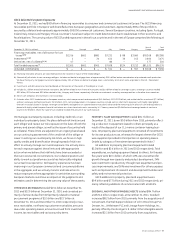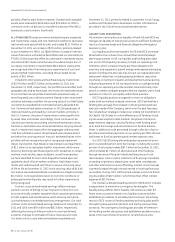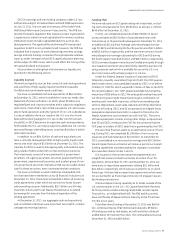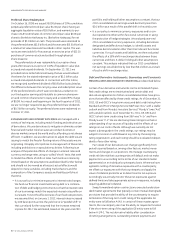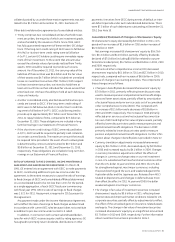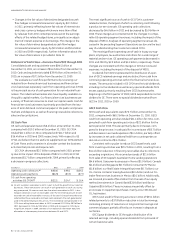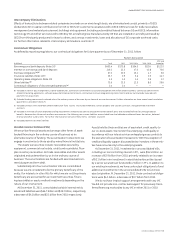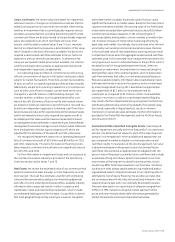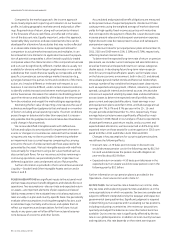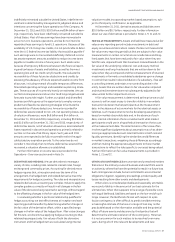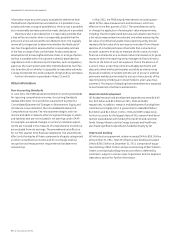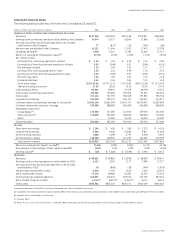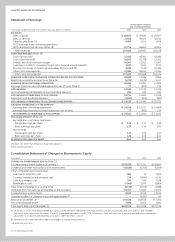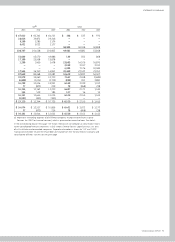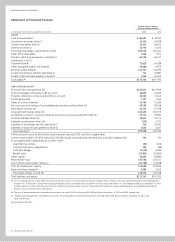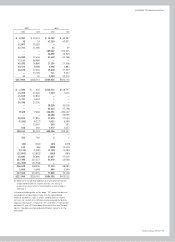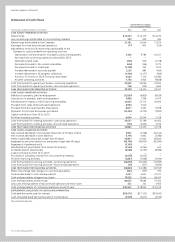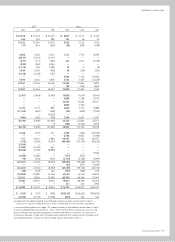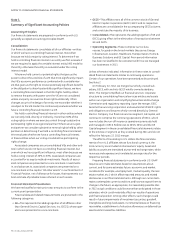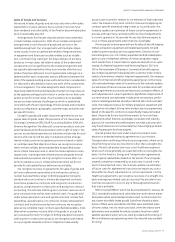GE 2011 Annual Report Download - page 69
Download and view the complete annual report
Please find page 69 of the 2011 GE annual report below. You can navigate through the pages in the report by either clicking on the pages listed below, or by using the keyword search tool below to find specific information within the annual report.’
GE 2011 ANNUAL REPORT 67
indefi nitely reinvested outside the United States. Indefi nite rein-
vestment is determined by management’s judgment about and
intentions concerning the future operations of the Company. At
December 31, 2011 and 2010, $102 billion and $94 billion of earn-
ings, respectively, have been indefi nitely reinvested outside the
United States. Most of these earnings have been reinvested in
active non-U.S. business operations, and we do not intend to
repatriate these earnings to fund U.S. operations. Because of the
availability of U.S. foreign tax credits, it is not practicable to deter-
mine the U.S. federal income tax liability that would be payable if
such earnings were not reinvested indefi nitely. Deferred income
tax assets represent amounts available to reduce income taxes
payable on taxable income in future years. Such assets arise
because of temporary differences between the fi nancial report-
ing and tax bases of assets and liabilities, as well as from net
operating loss and tax credit carryforwards. We evaluate the
recoverability of these future tax deductions and credits by
assessing the adequacy of future expected taxable income from
all sources, including reversal of taxable temporary differences,
forecasted operating earnings and available tax planning strate-
gies. These sources of income rely heavily on estimates. We use
our historical experience and our short and long-range business
forecasts to provide insight. Further, our global and diversifi ed
business portfolio gives us the opportunity to employ various
prudent and feasible tax planning strategies to facilitate the
recoverability of future deductions. Amounts recorded for
deferred tax assets related to non-U.S. net operating losses, net
of valuation allowances, were $4.8 billion and $4.4 billion at
December 31, 2011 and 2010, respectively, including $0.9 billion
and $1.0 billion at December 31, 2011 and 2010, respectively, of
deferred tax assets, net of valuation allowances, associated with
losses reported in discontinued operations, primarily related to
our loss on the sale of GE Money Japan. Such year-end 2011
amounts are expected to be fully recoverable within the appli-
cable statutory expiration periods. To the extent we do not
consider it more likely than not that a deferred tax asset will be
recovered, a valuation allowance is established.
Further information on income taxes is provided in the
Operations—Overview section and in Note 14.
DERIVATIVES AND HEDGING. We use derivatives to manage a
variety of risks, including risks related to interest rates, foreign
exchange and commodity prices. Accounting for derivatives as
hedges requires that, at inception and over the term of the
arrangement, the hedged item and related derivative meet the
requirements for hedge accounting. The rules and interpretations
related to derivatives accounting are complex. Failure to apply this
complex guidance correctly will result in all changes in the fair
value of the derivative being reported in earnings, without regard
to the offsetting changes in the fair value of the hedged item.
In evaluating whether a particular relationship qualifi es for
hedge accounting, we test effectiveness at inception and each
reporting period thereafter by determining whether changes in
the fair value of the derivative offset, within a specifi ed range,
changes in the fair value of the hedged item. If fair value changes
fail this test, we discontinue applying hedge accounting to that
relationship prospectively. Fair values of both the derivative
instrument and the hedged item are calculated using internal
valuation models incorporating market-based assumptions, sub-
ject to third-party confi rmation, as applicable.
At December 31, 2011, derivative assets and liabilities were
$10.0 billion and $0.7 billion, respectively. Further information
about our use of derivatives is provided in Notes 1, 9, 21 and 22.
FAIR VALUE MEASUREMENTS. Assets and liabilities measured at fair
value every reporting period include investments in debt and
equity securities and derivatives. Assets that are not measured at
fair value every reporting period but that are subject to fair value
measurements in certain circumstances include loans and long-
lived assets that have been reduced to fair value when they are
held for sale, impaired loans that have been reduced based on the
fair value of the underlying collateral, cost and equity method
investments and long-lived assets that are written down to fair
value when they are impaired and the remeasurement of retained
investments in formerly consolidated subsidiaries upon a change
in control that results in deconsolidation of a subsidiary, if we sell
a controlling interest and retain a noncontrolling stake in the
entity. Assets that are written down to fair value when impaired
and retained investments are not subsequently adjusted to fair
value unless further impairment occurs.
A fair value measurement is determined as the price we would
receive to sell an asset or pay to transfer a liability in an orderly
transaction between market participants at the measurement
date. In the absence of active markets for the identical assets or
liabilities, such measurements involve developing assumptions
based on market observable data and, in the absence of such
data, internal information that is consistent with what market
participants would use in a hypothetical transaction that occurs
at the measurement date. The determination of fair value often
involves signifi cant judgments about assumptions such as deter-
mining an appropriate discount rate that factors in both risk and
liquidity premiums, identifying the similarities and differences
in market transactions, weighting those differences accordingly
and then making the appropriate adjustments to those market
transactions to refl ect the risks specifi c to our asset being valued.
Further information on fair value measurements is provided in
Notes 1, 21 and 22.
OTHER LOSS CONTINGENCIES are uncertain and unresolved matters
that arise in the ordinary course of business and result from events
or actions by others that have the potential to result in a future loss.
Such contingencies include, but are not limited to environmental
obligations, litigation, regulatory proceedings, product quality and
losses resulting from other events and developments.
When a loss is considered probable and reasonably estimable,
we record a liability in the amount of our best estimate for the
ultimate loss. When there appears to be a range of possible costs
with equal likelihood, liabilities are based on the low-end of such
range. However, the likelihood of a loss with respect to a par-
ticular contingency is often diffi cult to predict and determining
a meaningful estimate of the loss or a range of loss may not be
practicable based on the information available and the potential
effect of future events and decisions by third parties that will
determine the ultimate resolution of the contingency. Moreover,
it is not uncommon for such matters to be resolved over many
years, during which time relevant developments and new


